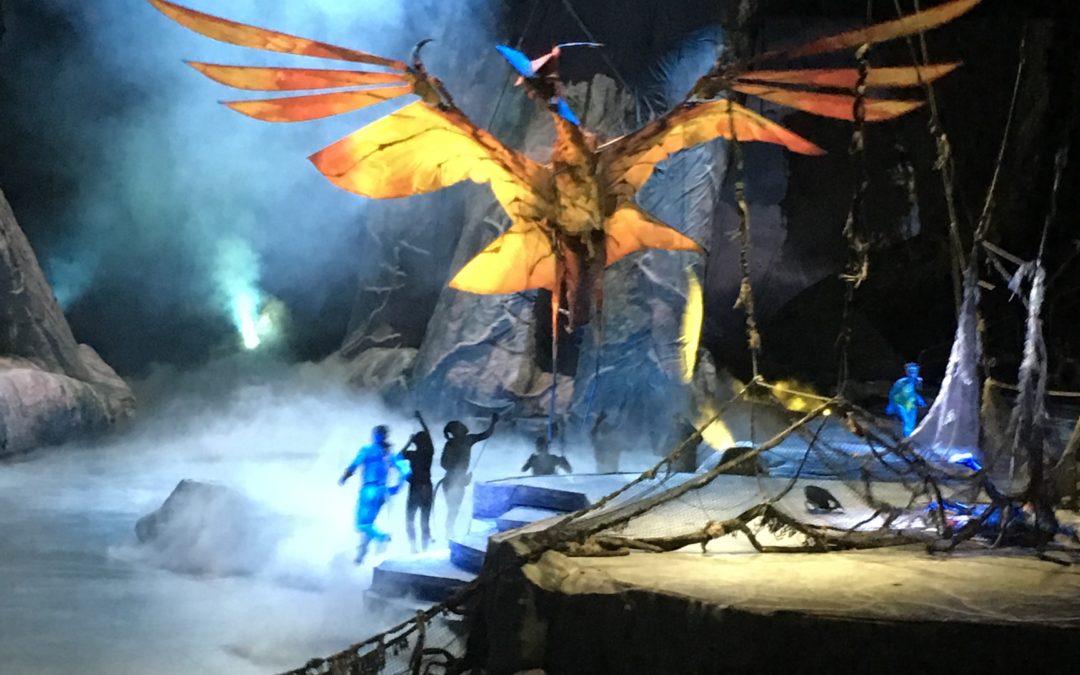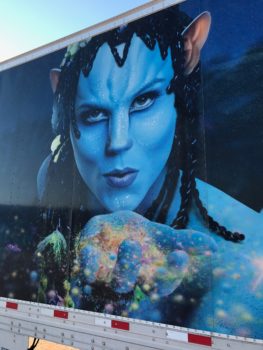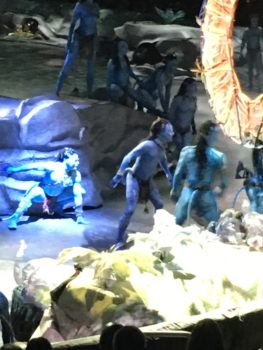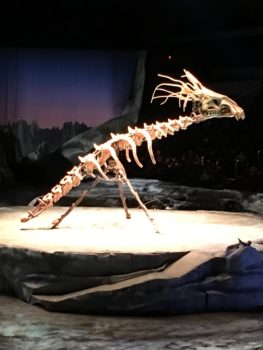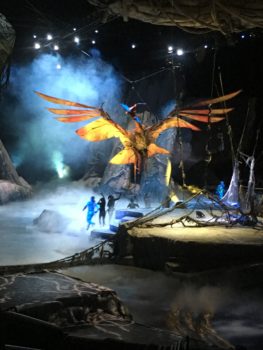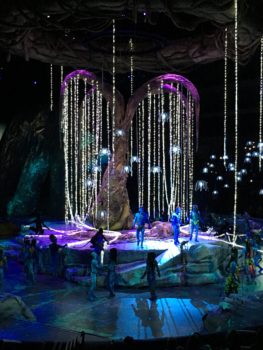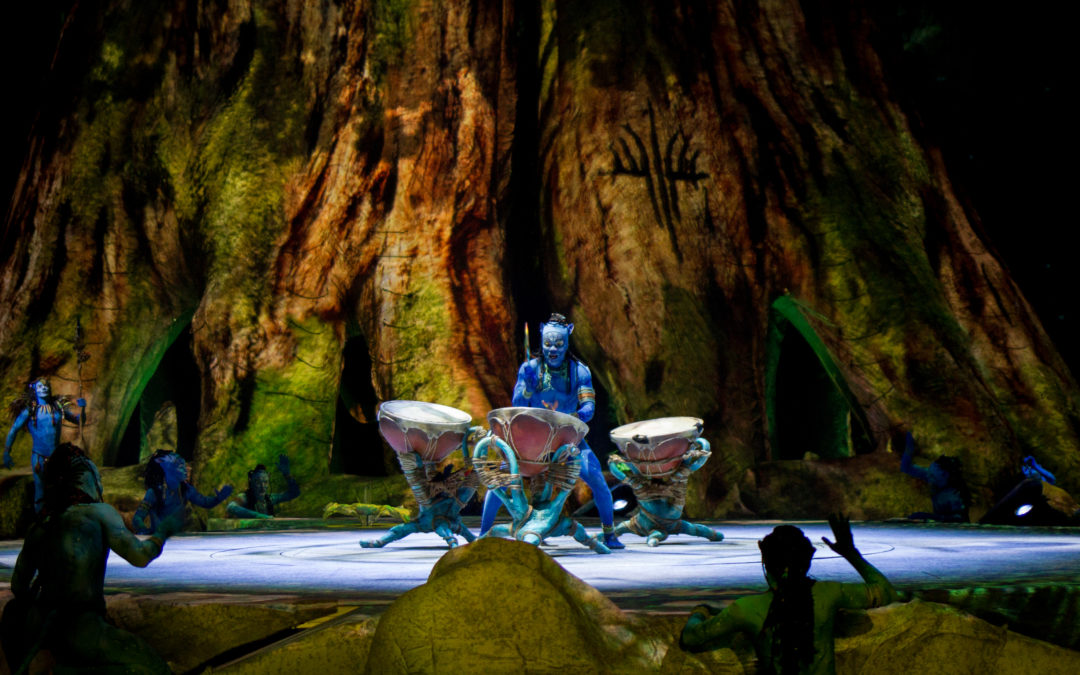
by Sharm | Jan 6, 2017 | Articles, Entertainment, Kansas City, Lifestyle & Technology, Wichita
This behind the scenes look at Cirque du Soleil’s TORUK – The First Flight is a mythical tale set thousands of years before the events depicted in the film AVATAR, and before any humans ever set foot on Pandora.
TORUK – The First Flight is a traveling Cirque du Soleil show that takes over 25 semi trucks full of props and equipment to pull off this visually stunning show.
When a natural catastrophe threatens to destroy the sacred Tree of Souls, Ralu and Entu, two Omaticaya boys on the brink of adulthood, fearlessly decide to take matters into their own hands.
Upon learning that Toruk can help them save the Tree of Souls, they set out, together with their newfound friend Tsyal, on a quest high up in the Floating Mountains to find the mighty red and orange predator that rules the Pandoran sky. Prophecy is fulfilled when a pure soul rises among the clans to ride Toruk for the first time and save the Na’vi from a terrible fate.
TORUK – The First Flight blends the world of AVATAR and the signature style of Cirque du Soleil with the pioneering artistic vision of multimedia stage directors Michel Lemieux and Victor Pilon.
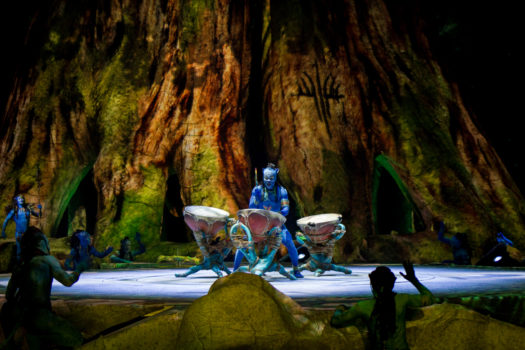
From video production to costumes and make-up, TORUK – The First Flight is a multimedia phenomenon.
Here are some fun facts from the media kit I received about what it takes to put on the show.
Pandora in All Its Splendor – Lemieux and Pilon, who also wrote the show, sought to convey the awe-inspiring beauty and vital impetus of the world of Pandora – Its rich textures, lush flora, and youthful buoyancy.
The multimedia projections that evoke the awe-inspiring landscapes – from the Floating Mountains and the Omaticaya Hometree, to the Anurai’s animal sanctuary and the lush jungles where the Tawkami live – create a visually stunning environment for the performers. So do the large-scale effects that come from the storyline, such as the earthquake and volcano eruption, the rivers of lava rising from within, and the Shaman’s visions projected on a huge floating, ethereal veil.
Some video effects are synched with the performers’ movements, such as the bioluminescent trails they leave in their wake as they meander through the forest. Some effects are mere evocations meant to create mood, like the creatures circling the sky appearing only in shadow form on the ground.
Video projections sometimes overflow beyond the set and right into the audience, giving spectators the feeling they’re not merely gazing at Pandora, but they’re actually ON Pandora. At one point, waves start in the audience before washing up on shore on stage; in another scene, a starry sky is projected all over the arena, virtually turning it into an upside-down planetarium.
Lemieux and Pilon are masters at creating virtual spaces on stage. In TORUK – The First Flight, they transform the set into a giant screen where Pandoran landscapes materialize. “Set changes, which sometimes occur in the wink of an eye, are not mechanical, but optical,” says Michel. “It’s the language of film applied to the performing arts,” adds Victor. “And we alternate between large-scale, spectacular effects and more intimate moments that evoke emotion.”
In a projections-rich production, lighting is crucial to adding volume to the performers, set elements and props. It focuses the audience’s attention on story. In TORUK – The First Flight, a state-of-the-art tracking system is used in unprecedented ways to help with this task. Hidden in their costumes, the artists wear a tracking device linked to follow spots and video projectors that react to their movements in real time.
PROJECTIONS CLOSEUPS
• Total projection surface, excluding projections that reach out into the audience, is approximately 20,000 square feet, more than five times the size of a standard IMAX screen: 12,750 for the stage, 3,600 for the two lateral screens, and another 3,600 for the two columns of Hometree.
• There are 40 video projectors in all: half are 30,000-lumen each, the other half, 20,000-lumen.
• 22 video projectors are used for projections on the ground; 6 projectors send video images on Hometree; 2 projectors are dedicated to the two lateral screens and 8 projectors are used for immersive projections into the audience.
SET DESIGN AND PROPS
Pandora is a fictional moon orbiting the gas giant Polyphemus in the Alpha Centauri system, the closest star system to our sun. It is home to the Na’vi, a highly spiritual people with a deep connection to nature. The moon’s environments range from tropical rainforest and equatorial desert to boreal forest, mountains, ocean shorelines, wetlands, and archipelago. Nature galore! As there are no constructions on Pandora, Set Designer Carl Fillion made it a point to avoid straight lines and to use only curvy, organic lines in his designs.
Five main elements make up the set – Hometree, the Island, the Green Belt, the Dream Catcher, and the two Lateral Screens.
The Omaticaya Hometree – On Pandora, Hometrees are two to three times the height of the redwoods that once covered the Pacific Northwest on Earth.
The bottom part of the columns of the Omaticaya Hometree loom 25 feet above the stage floor. Amid the bustle of daily life inside Hometree, one can see a Giant Loom – a kind of weaving machine that plays an important role in the daily lives of the Omaticaya.
The Island – There is an “island” at the center of the stage on which performers move about. The Island also houses a Fire Pit, a Circular Drum as well as the Tree of Souls, an inflatable structure stashed in a tiny trench under the stage floor. The tree structure is inflated as it is hoisted from the trench using cables attached to the structure above the stage. The branches of the tree are covered in thousands of LED lights.
The Green Belt – The terrain on Pandora is neither smooth nor flat. To create a fragmented topography that evokes the uneven landforms on Pandora, the Set. Designer created an elevated, padded bank – or Green Belt – all around the stage on which performers can climb and move around. The Green Belt ensures that images projected on the ground look more three-dimensional. It also doubles as a cover for the rink board. As Pandora is a world lush with vegetation, three dimensional retractable plants pop out of the Green Belt during scenes to evoke the forest environment.
The Dream Catcher – The Dream Catcher is a structure suspended 45 feet above the Island. It houses several props and set elements, including a huge plant 35 feet in diameter that serves as an acrobatic device. The structure recalls the Aboriginal dream catcher.
The Lateral Screens – The two large projection screens flanking the Omaticaya Hometree on each side extend the projection surface further out into the audience.
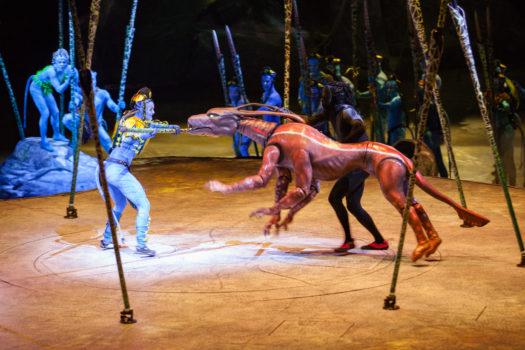
SET CLOSEUPS
The stage is 85 by 162 feet.
• The show’s performance area is based on the Fibonacci spiral. This shape is determined by the ancient number sequence in which each number is the sum of the two preceding numbers. It is said that botanists on Pandora have recognized this mathematical pattern in many botanical specimens with a fiddlehead shape. If one were to place the design of the Fibonacci spiral on the stage, the Tree of Souls would be in the exact spot at the heart of the spiral.
• Hometree is 80 feet wide by 40 feet high. The structure is equipped with wheels and stands on nine pivots. It can be moved by hand.
• The fabric that covers the entire performance area used as a projection surface during the Prologue comes in two parts, each measuring 200 by 90 feet wide.
COSTUMES AND MAKEUP
When she took on the challenge of interpreting for the stage the animated characters in AVATAR through costumes, Costume Designer Kym Barrett set out to respect the dress codes established by James Cameron’s team without copying exactly what was done in the movie. “While we worked within the parameters of Pandora, we had room to create our own version of the mythical first flight,” says Kym.
Since the movie is set 3,000 years in the future in relation to TORUK – The First Flight, the Costumer Designer needed to determine how the Na’vi’s clothing culture had changed over that period of time and, working backwards, create her designs accordingly.
The Omaticaya’s domestic culture revolved around weaving and bead-making and using the things they found in their natural surroundings – from seeds and vines and leaves, to bones and precious stones.
One look at the Storyteller’s mantle is enough to know that he is well traveled and has received various tokens from other clans over time. Likewise, the Shaman’s costume suggests that travelers to and from the Omaticaya’s home have brought
her ornaments and treasures that she has incorporated into her ceremonial robe.
The “Fabric” of Pandora – The costumes should look like they were made by Na’vi hands, hence the organic, handmade look to the wardrobe. Textures and prints were designed to overcome the fact that there are no fabrics on Pandora. The artisans in the costume department sought out materials that potentially looked like they were naturally available to the Na’vi in their environment. They “invented” Pandoran fibers that do not exist on Earth.
Some varieties of “extraterrestrial flora” used in the costumes are in reality cut-outs of loofah sponge or molds from cabbage leaves. A loincloth that looks like it was made from leaves is in fact made of crinoline, an open-weave horsehair and linen fabric usually stiffened and used for interlinings, skirts or underskirts.
Given the size of the performance space, great care has gone into ensuring the costumes look authentic. They are detailed and subtle enough to look handmade up close, but they look organic while remaining lustrous from afar.
Creating the Na’vi Skin – Before designing the first elements of the clan couture however, the team needed to address the epic challenge of reproducing the look of the Na’vi’s skin convincingly in terms of color and skin tone.
With its long, prehensile lemur-like tail, the body of the Na’vi is leaner and taller than a human’s. Acrobats do not generally fit this mold. By and large, performers in the circus arts world are more of a medium stature and more muscular than thin. The team had to start by establishing the muscle structure and the base print colors then create the Na’vi body stripes. They elongated the thorax as much as possible in order to replicate the Na’vi’s body form by raising the chest design a few inches on the costume in relation to the artist’s own chest.
Kym chose four different blue base skin tones to account for natural DNA variations among the Na’vi people. These skin colors had to work on all performers, regardless of their complexion.
Twenty-five different variations were created for the Na’vi base. The base skin fabric, an optical white synthetic fiber, was silkscreened to create the muscle and distinctive stripes. The bioluminescent effect is created using a product that reacts to the light filters used in the show.
The Costume of the Puppeteers, the “Spirits of Eywa” – The exotic fauna of Pandora is personified on stage through state-of-the-art puppetry. The challenge for the costume team was to determine how the puppeteers would manipulate the puppets without being identified as Na’vi, while remaining connected to the world of Pandora. To address this challenge, an all-black Na’vi costume was created.
Make-up and morphology – Although they are morphologically similar to humans, the Na’vi have a wider nose and larger eyes. To suspend the audience’s disbelief and create the illusion that the 35 performers on stage are in fact Na’vi, the make-up artists in the costume department needed to “remodel” the artists’ faces. In addition, countless hours were spent finding and creating unifying bioluminescent patterns that pass seamlessly between the printed fabric of the costume and the make-up, which is a unique foundation color that was created specifically for the show.
COSTUME CLOSEUPS
• As the base costume represents the bare skin of the Na’vi, the footwear has to imitate bare feet. The artists wear shoes contoured to the shape of the human foot, including visible individual sections for the toes.
• The flowers of the Tawkami costumes require 437 yards of fabric and 120 fishing rods.
• Some costumes are made with parts of hammocks.
• Bones were used as an inspiration to sculpt the Anurai decorations and to adorn the corset of the Storyteller.
• A drill or a hand mixer is used to prepare the wool materials that make up the braids in the hair of the Omaticaya characters.
• As turquoise silkscreen inks are extremely sensitive to sunlight, all costumes with this feature need to be covered with a black garment bag during storage.
• The black-clad, shadow-like puppeteers who personify the spirit of Eywa are a direct reference to the shadows in Plato’s “Allegory of the Cave.” Shadow play is a precursor of cinema.
• There are 115 costumes in the show, an average of 3.3 costumes per artist. The costume department produced more than 1,000 items in all, including shoes, headpieces and necklaces.
PUPPETS
When he dreamed up AVATAR, James Cameron created a coherent, highly structured world with its own set of codes and natural laws, including a living, breathing ecosystem with an exotic fauna.
When the creators of TORUK – The First Flight decided to evoke the creatures of Pandora on stage through the art of puppetry,
they could easily have turned to animatronics – animal figures animated by means of electromechanical devices. Instead, they chose to create bona fide puppets where the strings, rod or controls are intentionally left visible and the puppeteers are in full view.
Regardless of the technique, the goal remains to urge the spectator to suspend disbelief for a moment – to create the illusion that these are not mere objects made of metal and cloth, but living beings from a faraway moon. “On Pandora, the animals are strange, menacing and beautiful all at once. These six-legged muscular creatures exude a sense of grace and nobleness, which I wanted to convey. I wanted my designs to be a tribute to nature, as is the show,” says Puppet Designer Patrick Martel.
In TORUK – The First Flight, 16 puppets represent the creatures of Pandora: six Viperwolves, three Direhorses, three Austrapedes, one Turtapede, two swarms of Woodsprites, and one Toruk. The two swarms of Woodsprites are actually mobiles manipulated by puppeteers.
While the Viperwolves and Direhorses are directly inspired by the movie AVATAR, the Austrapedes and the Turtapede were created from scratch. When the creative team took on the challenge of imagining a show based on a pre-existing world – Pandora –, they dove head first into James Cameron’s world and used it as a springboard to explore uncharted territory. This meant creating new creatures as well. “Not only did we want to please AVATAR fans, we wanted to surprise them too,” says Patrick.
But the responsibility of adding new species to Pandora’s fauna was not taken lightly. The features of these new six-limbed creatures had to be consistent with the morphological standards of Pandora. And they are. It was a matter of respecting James Cameron’s work.
Puppet “Biology” – Since weight is an important factor when building large-scale puppets, most structures are made of aluminum or, whenever possible, carbon fiber, a material as flexible as it is lightweight. The inside of the puppets is Plastazote, which is ultra-light polyethylene foam. Stretch fabrics such as Lycra are used for the creatures’ skin, while the wings of Toruk are cut from polyester silk. The textures and patterns on the outside were printed using a technique called sublimation, which fixes the images in the fibers of the material.
Beware the Viperwolf! – With its low-slung head and snakelike jaw, the Viperwolf is a swift, fiercely intelligent animal that hunts in packs. The puppeteer uses his hands to control the upper body and articulated head of the Viperwolf, working each of the four front legs with his hand. The puppeteer moves the animal’s hind legs by giving the puppet a specific swinging motion. The Viperwolf puppet has green luminous eyes, is illuminated from the inside, and glows red and blue.
The swift and nimble Direhorse – The Direhorse is a wild, frisky animal. Two puppeteers work in unison inside the structure. The first controls the front part, including neck and head; his legs become the creature’s two front legs. The second puppeteer controls the middle legs with his hands; his legs become the animal’s hind legs. The puppeteers stand on platform shoes to better convey the creature’s impressive size.
The Austrapede, a cross between an ostrich, a pink flamingo and a dinosaur – With its long, thin neck and tail and its long, narrow bill, the Austrapede is a relatively small creature by Pandoran standards. The Austrapedes are impulsive, fidgety creatures whose emotions spread quickly from one individual to the other by a form of mimicry. A single puppeteer housed inside controls the neck and head with one hand, using his other hand to work the wings, which start flapping whenever the Austrapede is frightened. Perched on 7-inch-high platform shoes that give the animal its distinct hop, the puppeteer can see through the animal’s gills, which are a common feature of Pandoran fauna.
The Turtapede, a turtle and a shark folded into one – With its large dorsal fin and tail, the Turtapede is agile in shallow water. The puppeteer moves the sea-dwelling creature by pushing on the structure. He uses his arms to move the creature’s legs. The shell of the Turtapede has iridescent patterns that shimmer.
The Woodsprites, sacred seeds of the Tree of Souls – Two mobiles inspired by the work of sculptor Alexander Calder evoke the Woodsprites in all their aerial lightness and elegance. To reproduce their bioluminescent glow, each of the 20 seeds is equipped with a DEL light.
The Toruk, or Great Leonopteryx – The fierce and noble Toruk is an oversized marionette with a 40-foot wingspan. This type of traditional string puppet is usually much smaller and works upside down: the strings are normally manipulated from above instead of from below. The show’s Toruk works by reverse gravity and is suspended from a cable attached to an automation system that controls the creature’s movements in space. Six puppeteers on the ground control the other movements of the creature. It takes one puppeteer to control the head, two to direct the shoulders, two to work the wings, and one to control the tail – all in a synchronized aerial choreography.
Fourteen additional puppets appear in TORUK – The First Flight to evoke various animals on Pandora. These more rudimentary and impressionistic puppets, handcrafted by the Na’vi, are used in various rituals and ceremonies. Without the puppeteers, the fauna in the show would be inert and lifeless. They are the ones who breathe life into the creatures, hence the moniker “Spirits of Eywa.”
PUPPET CLOSEUPS
• The two Woodsprite mobiles deployed at the end of 19-foot poles each contain 20 illuminated “seeds.”
• The puppeteers are equipped with microphones and make their own animal sounds for perfect synchronization with their movements.
MOVEMENT
ACROBATIC PERFORMANCE AND CHOREOGRAPHY
“Acrobatic” Narrative – One of the biggest challenges during the creation of TORUK – The First Flight was to figure out how to portray the Na’vi in their “natural” environment in a credible way. Hence the idea of developing a different acrobatic language for this show.
The creative team wanted to convey the strength, physicality and agility of the Na’vi a setting that takes into account Pandora’s weaker gravity compared to Earth’s. Acrobatics are embedded in the storyline and the artists’ every move – from leaps and tumbles, to flips and somersaults. The stage floor was specially equipped with rebound surfaces to allow the artists to generate thrust and build momentum.
During the creative process, artists had to “unlearn” movements and gestures they had spent years assimilating in their training. They had to shun the laws of human biomechanics and learn how to move like the Na’vi. This new gestural language produced what Acrobatic Performance Designer Germain Guillemot calls “a music of the body.” Over time, the artists-cum-Na’vi began to look and behave like they
had just walked out of the big screen.
Group Dynamics – Each of the five clan in the show has features and skills that sets it apart from the others. To reflect this, the creative team assigned a distinct performance or movement signature to each clan.
Omaticaya – Giant Loom & Vines The giant loom that holds a special place in the everyday lives of the Omaticaya doubles as an apparatus. Artists climb up the structure and leap from one bar to the other, performing moves that borrow from various aerial acrobatic disciplines.
Anurai – Thanator Sculpture
An apparatus that recalls the skeleton of a Thanator – Palulukan in the Na’vi language – was created for the noble Anurai. The artists climb on the structure and perform a balancing ritual in honor of the Thanator.
Kekunan – Kites The art of indoor kite flying is used to evoke a colony of Mountain Banshees
during the scenes featuring the Kekunan, a clan that lives near the creatures’
breeding ground high up in the mountains. In certain scenes with Ralu, Entu
and Tsyal, the kites become characters in their own right.
Tipani – Poles and Staffs Valiant warriors, the Tipani are deft at manipulating poles and staffs during symbolic or ritual battles.
Tawkami – Pandoran Flora As for the Tawkami, proficient botanists known for their vast knowledge of plants and their healing properties, the oversize flora of Pandora serves as a showcase for the clan’s special abilities. Searching for potent seeds, Tsyal climbs up the pistils of an enormous flower suspended from above and performs moves that have all the earmarks of an aerial silk act. During the Tawkami scene, members of the clan celebrate the harvest by performing a balletic “floral” choreography: they manipulate banners made of ultralight fabric that evoke colorful leaves, plants and flowers, creating huge volumes that flow and undulate gracefully in space.
Choreographing Life on Pandora – During the creative process, co-choreographers Tuan Le and Tan Loc spent a lot of time with the cast exploring the show’s physical and acrobatic vocabulary in order to help drive the emotional momentum of the narrative. Using the film AVATAR as a creative springboard, they drew inspiration from the energy of the Na’vi to spark the creativity of the cast. Their goal was always to create individual or ensemble movements that look and feel “authentic” in order to persuade the audience to suspend disbelief.
Actress and former competitive gymnast Julene Renee was brought in to teach the artists how to move like the Na’vi. Known for her role in James Cameron’s AVATAR, she also worked with the actors of the film as a movement coach. Not only did Renee teach the artists the basic catlike movements of the Na’vi, she also explored with them the philosophy, language and sounds that are part of daily life on Pandora.
KITES
In the show, vigorous multicolored kites glide gracefully up above then swoop down, banking hard right and left in the blink of an eye, rising up again in power climbs before falling into spins and pulling out mere inches from the ground. On stage, these ingenious contraptions are the physical manifestations of the Banshees that roam the Pandoran sky. In essence, the kites in the show are the avatars of these winged predators. They are not mere tethered constructions; they are creatures of Pandora involved in the story. As such, they need to connect with the audience on an emotional level, particularly during the scenes with the trio.
KITE CLOSEUPS
• There are 18 kites in the show: 6 quads (kites equipped with four-line), 11 kites on poles, and 1 giant traction kite.
• During the scene in the Hallelujah Mountains, the 64,5-square-foot giant traction kite flies out over the audience. Spectators sitting up close can feel the gust of wind the kite makes as it whooshes by overhead.
• Traction kiting is an extreme form of kite flying. A traction kite is typically large enough to pull a vehicle on land, snow, ice or water. Since there is no wind indoors, it is the flyer who must generate the energy required to fly the kite. Interestingly, a traction kite that is flown indoors has the ability to glide forward just like a paper plane.
• During the Kekunan Clan scene, a group of 12 kite flyers perform simultaneously on stage.
MUSIC
Composers and Musical Directors Bob & Bill had to meet the challenge of creating otherworldly music that captures the vibe of Pandora, in addition to composing cinematic-sounding transitions between scenes that blend perfectly with the “Na’vi” sound. The composers lugged their equipment out in the woods to record the beats for the show’s soundtrack in order to achieve as natural and organic a sound as possible. Instead of using drumsticks to compose the different rhythmic patterns, the composers used objects or phenomena in nature – footsteps on dry leaves, a stick hitting the trunk of a tree, a branch slapping the ground, etc. Many of the beats recorded in the woods were used as is, and not as mere samples doctored in the studio.
In addition to coming up with an overall show sound, Bob & Bill created a specific signature for each of the five clans, each with its own theme, timbre, instruments and voices. Even the fierce predator Toruk has its own unmistakable two-note theme. The composers turned to Paul Frommer – the linguistics expert who invented the Na’vi language for James Cameron’s AVATAR – to translate into Na’vi the lyrics to all of the songs written for the show. Bob & Bill also drew inspiration from the musical instruments and theory explained in-depth in the Pandorapedia, James Cameron’s official field guide to the world of AVATAR.
MUSIC CLOSEUPS
• For the forest-dwelling Omaticaya, wood instruments, flutes and the everyday
sounds of the village were used to create beats.
• World renowned countertenor Daniel Taylor lent his voice to create the signature sound of the noble Anurai. Hollow sticks were used to create beats associated with these hunters who live in an animal sanctuary littered with animal bones.
• A female singer and a male percussionist perform live on stage along with the
pre-recorded soundtrack that makes up the show’s soaring cinematic score.
CREATIVE TEAM
TORUK – The First Flight comprises 13 creators under the artistic guidance of
Guy Laliberté (Guide) and Jean-François Bouchard (Creative Guide) for Cirque du
Soleil, and James Cameron, Jon Landau, Kathy Franklin and Richie Baneham for Lightstorm Entertainment.
